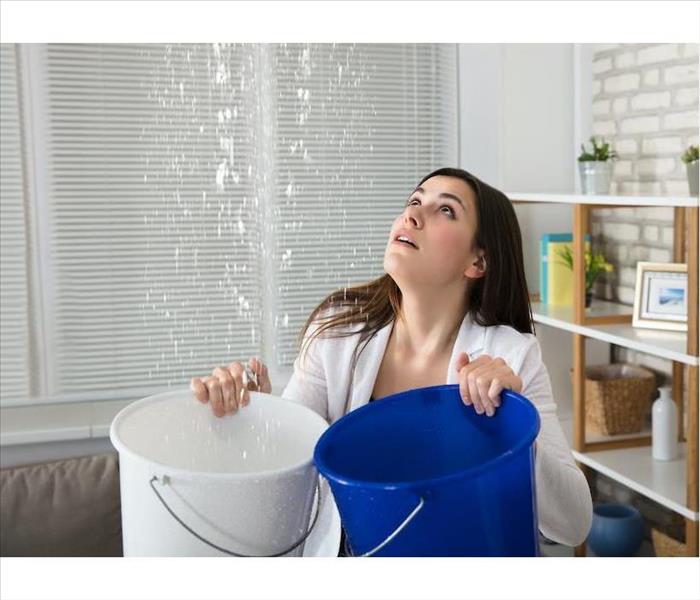Why Are Professional Restoration Services Required to Fix Household Water Damage?
4/29/2020 (Permalink)
Easing the Stress and Worry of Riverhead Residents -- Why SERVPRO Provides Fast and Expert Water Loss Assistance
When a water emergency devastates your comfortable Riverhead home, you need solutions from a company devoted to transforming the mess and chaos you experience back to preloss condition. Until it happens to you, the destruction that water can inflict on your home’s structural components and contents is unknown. After the disaster occurs, the aftermath becomes unimaginable. Whether from plumbing or appliance failure, a roof leak, storm damage, or flooding, incursions of water pose severe consequences to members of our community, why we strive to deliver the help you need.
What Can Cause Water Damage in My Home?
Water damage in Riverhead happens fast and from many sources. Our community is surrounded by water. Located at the mouth of the Peconic River, where the North and South Forks of Long Island diverge, Long Island Sound borders to the north and Great Peconic Bay to the east. Changing seasons and storms can force rain and seawater inside, causing catastrophic effects. But the most common reasons for water damage is less dramatic while still disastrous--plumbing leaks, spills, and malfunctioning household machines like dish and clothes washers, ice makers, water heaters, and more.
How Does Water Damage Affect My House?
Water losses in residential buildings impact two categories of property. The first concern is the structure itself. Water damages building materials in many ways, including:
Walls
- Water soaks into drywall, causing the composite material to swell and crumble.
- Lath and plaster construction resists water longer, but the wooden laths eventually swell, and the mortar between them breaks down, causing flaking and cracking of the plaster surface.
- Wet insulation between and behind walls packs down, decreasing or eliminating its value in moderating temperature.
Framing and Other Structural Supports
- Wood framing swells and warps, eventually weakening to the point where its load-bearing function declines, creating safety hazards.
- Metal supports and fasteners rust and break
- Joists and subfloors warp and weaken, disturbing the more decorative hardwood, tile, or laminate surface above.
- Door and window frames distort, preventing the optimal functioning of these features.
Flooring
- Laminate flooring cannot withstand any prolonged exposure to standing water, peeling apart, and requiring replacement.
- Resilient tile might detach if water invades beneath.
- Ceramic tiles can pop up if the subfloor swells, especially if the grout is cracked and allow water to percolate below.
- Hardwood floors can cup or crown, the planks or strips swelling on the edges or the center as the subfloor wicks moisture up.
- In extreme cases, hardwood floors can buckle, where the strips pull up and away from the subfloor.
Ceilings
- Ceiling tiles can detach and fall.
- Plaster or drywall ceilings can hold many gallons of water, creating an overhead hazard as the materials peel, bulge, and crack.
The second category of water damage concern includes the stress placed upon all of the contents, the furnishings, household goods, and personal possessions inside the structure.
Furniture
- Wooden frames can swell, glue dissolve and detach, and paint and varnish stain floor coverings.
- Upholstered furniture endures damage to fabrics and padding, creating a welcoming environment for mold growth and damage.
- Metal fasteners and supports rust, bend, and twist.
Floor Coverings
- Rugs and carpets both sustain significant harm when wet, stretching, ripping, staining, and delaminating, a process where layers of fiber peel away from the backing.
- Pads soak up water and increase the chances of mold development.
Papers
- Documents, books, and pictures all absorb moisture, inks dissolving, and the cellulose-based materials deteriorating.
Electronics
- A wide array of devices might malfunction and can shock users.
Appliances
- Subject to corrosion, and their wiring deteriorates, exposing food to spoilage in the case of freezers and refrigerators.
Textiles
- Linens, clothing, window coverings, and other fabrics can break down, and mold and mildew proliferate.
- Bedding absorbs water, becoming an incubator for microbial growth and odors.
Can One Restoration Company Manage All Aspects of a Residential Water Crisis?
Reading through this admittedly partial listing of the damage water can do can create panic, why SERVPRO is the partner you need to recover from this multifaceted emergency. Our comprehensive training and experience in the hundreds of ways water affects contents are essential to the successful restoration of not only your structure and its contents but also your way of life.
What Happens During Professional Water Damage Restoration?
We focus on two major activities designed to mitigate and remediate the water loss.
Water Removal
Why is water removal the first phase?
Studies show that the more liquid water removed, the faster and more effective the drying out of structures and contents proceeds. This is why we:
- Pump water more than two inches deep
- Extract all visible water with powerful truck-mounted and portable equipment
Structural and Content Drying
Why do we actively dry out spaces and items?
Relying on time and open windows to evaporate the water absorbed into building materials and contents is inefficient and not practical when the weather is cold or wet. Research-based drying methods we use include:
- Gathering moisture data to determine drying goals
- In the structure, positioning air movers and moderating temperature to move water from materials into the air as a vapor for dehumidifiers to capture
- Contents have many drying challenges, which is why SERVPRO often recommends pack-outs to our production facility where we can use resources such as:
- Contained smaller drying spaces for furnishings
- Freeze-drying for papers and photos
- Industrial washers and dryers for textiles
Training, equipment, and experience in a multitude of water damage scenarios are why SERVPRO of The North Fork can make it “Like it never even happened.” Call as soon after the water crisis as possible at (631) 591-3771.

 24/7 Emergency Service
24/7 Emergency Service
